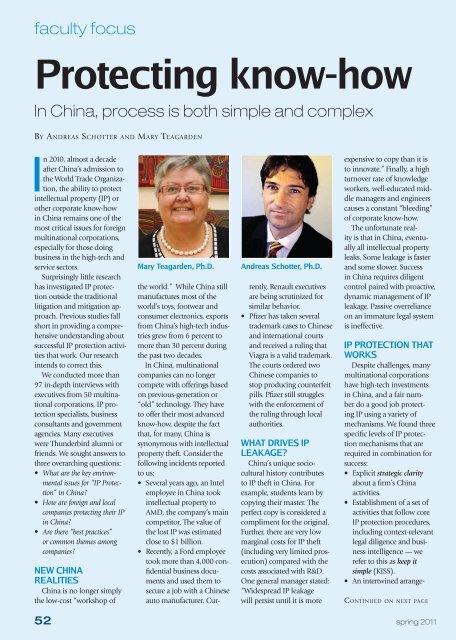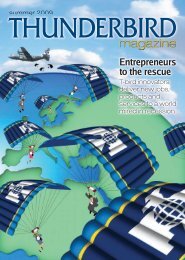Spring 11 MASTER.indd - Thunderbird Magazine
Spring 11 MASTER.indd - Thunderbird Magazine
Spring 11 MASTER.indd - Thunderbird Magazine
Create successful ePaper yourself
Turn your PDF publications into a flip-book with our unique Google optimized e-Paper software.
faculty focus<br />
Protecting know-how<br />
In China, process is both simple and complex<br />
BY ANDREAS SCHOTTER AND MARY TEAGARDEN<br />
In 2010, almost a decade<br />
after China’s admission to<br />
the World Trade Organization,<br />
the ability to protect<br />
intellectual property (IP) or<br />
other corporate know-how<br />
in China remains one of the<br />
most critical issues for foreign<br />
multinational corporations,<br />
especially for those doing<br />
business in the high-tech and<br />
service sectors.<br />
Surprisingly little research<br />
has investigated IP protection<br />
outside the traditional<br />
litigation and mitigation approach.<br />
Previous studies fall<br />
short in providing a comprehensive<br />
understanding about<br />
successful IP protection activities<br />
that work. Our research<br />
intends to correct this.<br />
We conducted more than<br />
97 in-depth interviews with<br />
executives from 50 multinational<br />
corporations, IP protection<br />
specialists, business<br />
consultants and government<br />
agencies. Many executives<br />
were <strong>Thunderbird</strong> alumni or<br />
friends. We sought answers to<br />
three overarching questions:<br />
• What are the key environmental<br />
issues for “IP Protection”<br />
in China?<br />
• How are foreign and local<br />
companies protecting their IP<br />
in China?<br />
• Are there “best practices”<br />
or common themes among<br />
companies?<br />
NEW CHINA<br />
REALITIES<br />
China is no longer simply<br />
the low-cost “workshop of<br />
Mary Teagarden, Ph.D.<br />
Andreas Schotter, Ph.D.<br />
the world.” While China still<br />
manufactures most of the<br />
world’s toys, footwear and<br />
consumer electronics, exports<br />
from China’s high-tech industries<br />
grew from 6 percent to<br />
more than 30 percent during<br />
the past two decades.<br />
In China, multinational<br />
companies can no longer<br />
compete with offerings based<br />
on previous-generation or<br />
“old” technology. They have<br />
to offer their most advanced<br />
know-how, despite the fact<br />
that, for many, China is<br />
synonymous with intellectual<br />
property theft. Consider the<br />
following incidents reported<br />
to us:<br />
• Several years ago, an Intel<br />
employee in China took<br />
intellectual property to<br />
AMD, the company’s main<br />
competitor. The value of<br />
the lost IP was estimated<br />
close to $1 billion.<br />
• Recently, a Ford employee<br />
took more than 4,000 confidential<br />
business documents<br />
and used them to<br />
secure a job with a Chinese<br />
auto manufacturer. Currently,<br />
Renault executives<br />
are being scrutinized for<br />
similar behavior.<br />
• Pfizer has taken several<br />
trademark cases to Chinese<br />
and international courts<br />
and received a ruling that<br />
Viagra is a valid trademark.<br />
The courts ordered two<br />
Chinese companies to<br />
stop producing counterfeit<br />
pills. Pfizer still struggles<br />
with the enforcement of<br />
the ruling through local<br />
authorities.<br />
WHAT DRIVES IP<br />
LEAKAGE?<br />
China’s unique sociocultural<br />
history contributes<br />
to IP theft in China. For<br />
example, students learn by<br />
copying their master. The<br />
perfect copy is considered a<br />
compliment for the original.<br />
Further, there are very low<br />
marginal costs for IP theft<br />
(including very limited prosecution)<br />
compared with the<br />
costs associated with R&D.<br />
One general manager stated:<br />
“Widespread IP leakage<br />
will persist until it is more<br />
expensive to copy than it is<br />
to innovate.” Finally, a high<br />
turnover rate of knowledge<br />
workers, well-educated middle<br />
managers and engineers<br />
causes a constant “bleeding”<br />
of corporate know-how.<br />
The unfortunate reality<br />
is that in China, eventually<br />
all intellectual property<br />
leaks. Some leakage is faster<br />
and some slower. Success<br />
in China requires diligent<br />
control paired with proactive,<br />
dynamic management of IP<br />
leakage. Passive overreliance<br />
on an immature legal system<br />
is ineffective.<br />
IP PROTECTION THAT<br />
WORKS<br />
Despite challenges, many<br />
multinational corporations<br />
have high-tech investments<br />
in China, and a fair number<br />
do a good job protecting<br />
IP using a variety of<br />
mechanisms. We found three<br />
specific levels of IP protection<br />
mechanisms that are<br />
required in combination for<br />
success:<br />
• Explicit strategic clarity<br />
about a firm’s China<br />
activities.<br />
• Establishment of a set of<br />
activities that follow core<br />
IP protection procedures,<br />
including context-relevant<br />
legal diligence and business<br />
intelligence — we<br />
refer to this as keep it<br />
simple (KISS).<br />
• An intertwined arrange-<br />
CONTINUED ON NEXT PAGE<br />
52 spring 20<strong>11</strong>

















